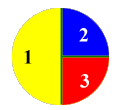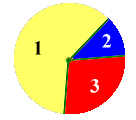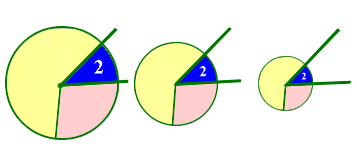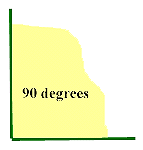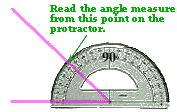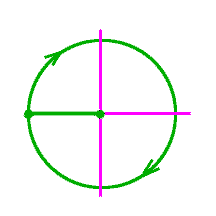From Geometry to Probability
|
Making spinners and doing probability experiments with them can be a lot of fun even for people who can solve problems without hands-on activities. Discarded CDs make good spinners. Mentor: In the game we will study, players make a spinner, then agree on what each of them wins if his or her color is chosen. For example:
Player 1 wins 10 points when the spinner stops at yellow. Player 2 wins 16 points when the spinner stops at blue. Player 3 wins 24 points when the spinner stops at red. Is the game fair? How can you tell? What are the chances of each player winning points in one spin? Student 1: Players 2 and 3 have the same chances of winning. Player 1 has twice as many chances. Student 2: Player 1 "owns" half the spinner, and Players 2 and 3 each "own" a quarter of the spinner. If we want to express their probability of winning in mathematical language, we can write: P (Player 1 winning) = 1/2 = .5 or 50% P (Player 2 winning) = 1/4 = .25 or 25% P (Player 3 winning) = 1/4 = .25 or 25% Mentor: If the game is played many times, which player do you expect to gain more points? Student 1: I think Player 2 will win about as many games as Player 3, but Player 3 gets more points each time.... I expect Player 3 to win more points than Player 2. Student 2: Let us use "the one hundred experiments trick" to compare players to Player 1. In one hundred experiments, we can expect: Player 1 to win 10 points 1/2 of 100 times, or to win 10*1/2*100 = 500 points, on the average 10*1/2*100/100 = 10*1/2 = 5 points per spin. Player 2 to win 16 points 1/4 of 100 times, or to win 16*1/4*100 = 400 points, on the average 16*1/4*100/100 = 16*1/4 = 4 points per spin. Player 3 to win 24 points 1/4 of all times, on the average 24*1/4 = 6 points per spin. Student 1: Now I can see that Player 3 is better off than the rest of them! Mentor: Can you change the number of points each player gets to make the game fair? If Player 1 gets 4 points, how many points should Player 2 and Player 3 get to make the game fair? What if Player 1 gets 20 points? What if Player 1 gets N points? This N means we do not know exactly how many he gets. We are just looking for the connection between the number of points Player 1 gets and the numbers Players 2 and 3 get. Student: Let us see... Players 2 and 3 are expected to win about half as many games as Player 1, so they have to get twice as many points every time they win. That makes 2*N for each of them.
Mentor: Let us look at a different spinner, something like this:
Student 1: How do we measure each player's chances now? Student 2: It would be nice if we could measure each player's "slice" exactly. How would you do it? Mentor: People measure things by comparing them with standard units. You can say that a show is 25 minutes long, a tree is 12 meters high, or a dog weighs 23 kilograms. We can use certain units to measure each player's "slice," or sector, of the spinner. Before we start, please tell me what is different and what is the same about these three spinners:
Student 1: It does not matter for the game which of the spinners is used. The chances of each color being chosen are the same. Student 2: The angles of each color are the same.
Mentor: Traditionally, people measure angles in special units called " degrees." These units were chosen in such a way that the following easy-to-measure angle is 90 degrees:
This angle is called a right angle. A third of the right angle is 30 degrees, for example, and so on. There is a useful tool that can be used to measure angles. It is called a protractor . It has units for degrees, much like a ruler has units for centimeters or inches. You can measure an angle by aligning the bottom of the protractor with one side of the angle, placing it so that the center of the protractor is at the vertex of the angle:
Student 1: The whole circle's angle is 360 degrees, because there are four right angles in it:
Student 2: It means that each player has as many chances as his angle has degrees, out of the total of 360 chances. Mentor: What angle will give you a 1/3 probability of winning? Student: A third of 360 degrees, or 120 degrees. Mentor: You can make some spinners for the game and find the exact chances of each player winning by measuring angles. Make the game fair by choosing how many points each player wins. Then play the game many times and see if the chances and actual winnings are close to what you predicted. From Probability to Geometry Mentor: In the spinner game above we used geometry (measuring angles) to find the probability of each player winning. Can you think of other examples where we can measure something and determine the chances of some particular outcome happening? Student 1: We can measure area. Suppose we drop something on a surface and find the chances of it hitting a specific part of the surface. Student 2: Yes, for example, what are the chances that a meteorite hitting the Earth will land in water? We need to know the total area of the Earth and the total area of the oceans, seas, lakes and rivers to answer that question. Mentor: Can you think of an example using volume? Student 1: OK. We are working in a gold mine. We have a load of regular sand mixed with gold sand. What are the chances that a grain we choose is made of gold? We will have to measure the volume of gold in the sand to find the answer. Student 2: To do that, you will need to get all the gold out. After that, who will care about the chances? The sand will not be mixed anymore, and you won't mix it just to repeat the experiment! Mentor: Maybe the manager who has to decide if it makes any sense to refine the next load of sand will care about the chances? Your question leads us right into the topic of how people can use probability to answer questions about geometrical measurements. Suppose you want to measure how much gold is in your sand. To do that exactly, you will have to extract all the gold. What if it is not worth it? What would you do? Student: I would take a few buckets of sand and find exactly how much gold is in them. If a third of the sand in the buckets is gold, then about a third of all the sand is also gold. Mentor: So you would randomly choose some sand and find the probability of finding gold in it. Let us see if probability can help us measure the angles on spinners. If you do not have a protractor, how can you use the probability to estimate the yellow, blue and red angles on this spinner?
Student: I can spin it many times and record which color is chosen each time. If the yellow is chosen 65% of the time, then the yellow angle is about 65% of the circle, or 360*.65 = 234 degrees. Mentor: Will it be an exact measurement or an estimate? Student: An estimate. |

